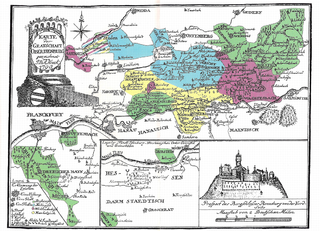
Isenburg was a region of Germany located in southern present-day Hesse, located in territories north and south of Frankfurt. The states of Isenburg emerged from the Niederlahngau, which partitioned in 1137 into Isenburg-Isenburg and Isenburg-Limburg-Covern. These countships were partitioned between themselves many times over the next 700 years.

Isenburg-Büdingen was a County of southern Hesse, Germany, located in Büdingen. It was originally a part of the County of Isenburg.

Isenburg-Meerholz was a County of southern Hesse, Germany. It was created as a partition of Isenburg-Büdingen in 1687, and was mediatised to Isenburg in 1806. In 2007, with the addition of Romania and Bulgaria, Meerholz became the European Union's new geographical center.
Isenburg-Philippseich was a County of southern Hesse, Germany. It was created in 1711 as a partition of Isenburg-Offenbach, and was mediatised to Isenburg in 1806.

Isenburg-Wächtersbach was a County of southern Hesse, Germany. It was created in 1673 as a partition of Isenburg-Büdingen, and was mediatised to Isenburg in 1806. In 1865, the Head of this line of the family, Ferdinand Maximilian was raised to the rank of Prince.
Wied was a County of Rhineland-Palatinate, Germany, located on the river Wied where it meets the Rhine. Wied emerged as a County earlier than many other German states. From 1243–1462, Wied was united with an Isenburgian County as Isenburg-Wied. Wied was partitioned twice: between itself and Wied-Dierdorf in 1631, and between Wied-Neuwied and Wied-Runkel in 1698. Via William of Albania, the House of Wied ruled the Principality of Albania in 1914.
Isenburg-Birstein was the name of two German historical states centred on Birstein in southeastern Hesse, Germany. The first "Isenburg-Birstein" was a County and was created as a partition of Isenburg-Büdingen-Birstein in 1628. It was merged into Isenburg-Offenbach in 1664. The second "Isenburg-Birstein" was a Principality, created as a partition of Isenburg-Offenbach in 1711. It was renamed the "Principality of Isenburg" in 1806.
Isenburg-Büdingen-Birstein was a County of southern Hesse, Germany, located to the north of Gelnhausen. Isenburg-Büdingen-Birstein was created as a partition of Isenburg-Büdingen in 1511, and was partitioned into Isenburg-Birstein, Isenburg-Büdingen, and Isenburg-Offenbach in 1628.
Nieder-Isenburg was a small mediaeval County in northern Rhineland-Palatinate, Germany. It was located to the east of the town of Neuwied, due north of Vallendar.
Isenburg-Kempenich was the name of a state of the Holy Roman Empire, based around Kempenich in modern Rhineland-Palatinate, Germany.

The 'Huguenot city' of Neu-Isenburg is a town in Germany, located in the Offenbach district of Hesse. It is part of the Frankfurt Rhein-Main urban area and has a population of 35,472 (2007). The town is known nowadays mainly for its regionally used shopping centre, the Isenburg-Zentrum (IZ), the Hugenottenhalle, the Hotel Kempinski Frankfurt, the Autokino Gravenbruch, the Sportpark, the Waldschwimmbad and not least of all its central location near Frankfurt Airport.
Isenburg-Neumagen was the name of a state of the Holy Roman Empire, seated in Neumagen-Dhron in modern Rhineland-Palatinate, Germany.
Isenburg-Grenzau was the name of several states of the Holy Roman Empire, seated in the Lordship of Grenzau, in modern Rhineland-Palatinate, Germany. The first state called Isenburg-Grenzau existed 1158–1290; the second 1341–1439; and the third 1502–1664.
Isenburg-Arnfels was the name of a state of the Holy Roman Empire, located in the Bad Hönningen area in modern Rhineland-Palatinate, Germany.
Gerlach I of Isenburg-Arnfels was the Count of Isenburg-Arnfels from 1286 (1287) until 1303.
Isenburg-Offenbach was the name of a state of the Holy Roman Empire, based around Offenbach and Neu Isenburg in modern Hesse, Germany. It was created as a partition of Isenburg-Büdingen-Birstein in 1628. In 1711 the immediacy passed to Isenburg-Birstein while the line was partitioned into Isenburg-Eisenberg and Isenburg-Philippseich.
Isenburg-Eisenberg was the name of a junior, non-immediate line of the House of Isenburg. It was partitioned from Isenburg-Offenbach in 1711, and became extinct in 1758.
Isenburg-Braunsberg was the name of a state of the Holy Roman Empire, based around Braunsberg in modern Rhineland-Palatinate, Germany. It was created as a partition of Isenburg-Isenburg in 1199 (1210). In 1338 Isenburg-Braunsberg became an Imperial County. It slowly acquired territories of the County of Wied, being renamed to Isenburg-Wied in 1388.
Isenburg-Covern was the name of a state of the Holy Roman Empire, based around Kobern-Gondorf in modern Rhineland-Palatinate, Germany. It was partitioned from Isenburg-Limburg-Covern in 1158. After the counts became extinct in 1306 it was annexed by Isenburg-Cleberg.
The term Upper Hesse originally referred to the southern possessions of the Landgraviate of Hesse, which were initially geographically separated from the more northerly Lower Hesse by the County of Ziegenhain.







